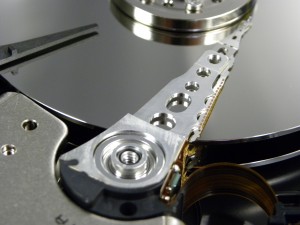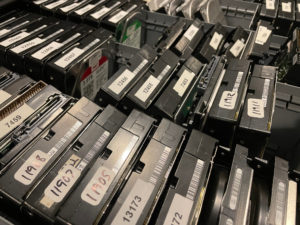At Datarecovery.com, we’ve helped hundreds of thousands of computer users recover from hard drive failures — but many of those consumers are mystified when we return data on a separate device.
That leads to an obvious question: Why can’t we simply repair the original hard drive to a like-new condition?
In short, hard drive repair services don’t really exist (and if you find a company offering “repair” services, our best advice is to run away). To understand why, let’s explain what data recovery technicians do — and the challenges they need to address during the recovery process.
Most data loss occurs when a hard drive or other storage device malfunctions.
For hard drives, the most common cause of data loss is an actuator head failure, which happens when the actuator heads (which read and write data) become misaligned with the magnetic platters that store data. 
Some of these “hard drive crashes” are literal: The actuator heads can come into physical contact with the platters. This may result in unusual noises such as clicking, whirring, or grinding sounds. However, some severe head crashes are completely silent — a good reason to keep your hard drive powered off after a failure.
While head crashes are common, other data loss scenarios may cause similar symptoms:
- Spindle motor seizure
- Printed circuit board (PCB) damage
- Firmware corruption
- Damage to the master boot record (MBR)
- Malware infection
Often, a failed hard drive will have several of these issues. We perform a free media evaluation on all standard hard drive data recovery cases in order to create a comprehensive plan for the next steps of the process (learn more about our free media evaluations here).
Data recovery engineers must “repair” the underlying issues to restore the drive’s data.
Hard drives are extremely precise devices, and they’re prone to damage from dust and other microcontaminants. To safely repair damaged actuator heads and other components, engineers need to work in a certified cleanroom.
In a sense, engineers are “repairing” the hard drive when recovering the data. They’re restoring damaged components to a working condition. However, that doesn’t mean that the drive is performing at 100% capacity after the repairs are completed.
A Brief Overview of Hard Drive Firmware
So, why not? For starters, hard drives have advanced firmware, which is specific to the model and revision number. Some parts of the firmware are specific to the drive itself — in other words, you can’t simply swap the electronics from two hard drives, even if they were manufactured at the same time.
If a hard drive has been repaired, the parameters of the firmware may need to be changed (after all, the drive’s internal components have changed). Restoring the drive to 100% of its pre-failure performance capacity would essentially require re-manufacturing the drive. Even then, the chances of another failure would be higher, since some of the components have more physical wear than others.
Additionally, hard drive failures may result in data corruption, and the platters may have sustained permanent damage. These issues need to be addressed by a recovery technician, and even after the process is complete, the hard drive is not a reliable device for long-term data storage.
Related: A Look Inside Datarecovery.com’s Hard Drive Parts Inventory
After completing data recovery procedures, engineers will immediately make a copy of the drive.
Creating this copy may take hours or even days, depending on the nature of the failure and the extent of the repairs. This is because engineers may operate the drive at a slower-than-normal speed to reduce the chances of an additional failure.
By working from this copy (or clone), the engineers can address problems like data corruption without risking the original copy. Once the data has been fully recovered and verified, it is copied to another device — the return media — and returned to the client.
If engineers simply repaired physical media issues and returned the original device to the user, many people would lose their data immediately (and after paying a hefty price for the service). Many files would be corrupt and unreadable. Even if the hard drive was operational, it would have a much higher chance of failure than a brand-new device.
For modern devices, most hard drive failures do not result in permanent data loss.
Here’s the good news: Modern data recovery techniques are extremely advanced, and success rates have climbed throughout the industry over the past decade. If you’ve lost data due to a hard drive failure, you’ve got options.
Datarecovery.com offers free evaluations, and our no data, no charge guarantee gives you complete peace of mind as your case progresses. With state-of-the-art laboratories at every location, we’re ready to help you recover from virtually any data loss disaster.
Get started by setting up a case online or call 1-800-237-4200.




